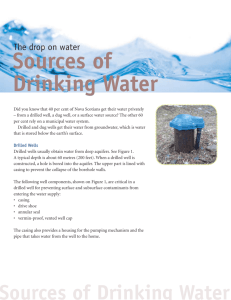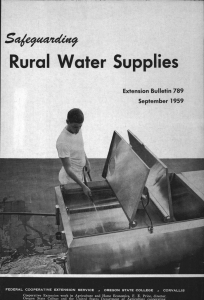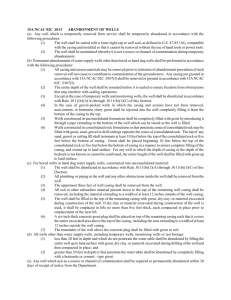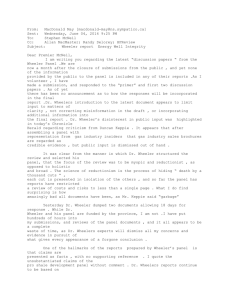Private Water Well Information - Fulton County Health Department
advertisement
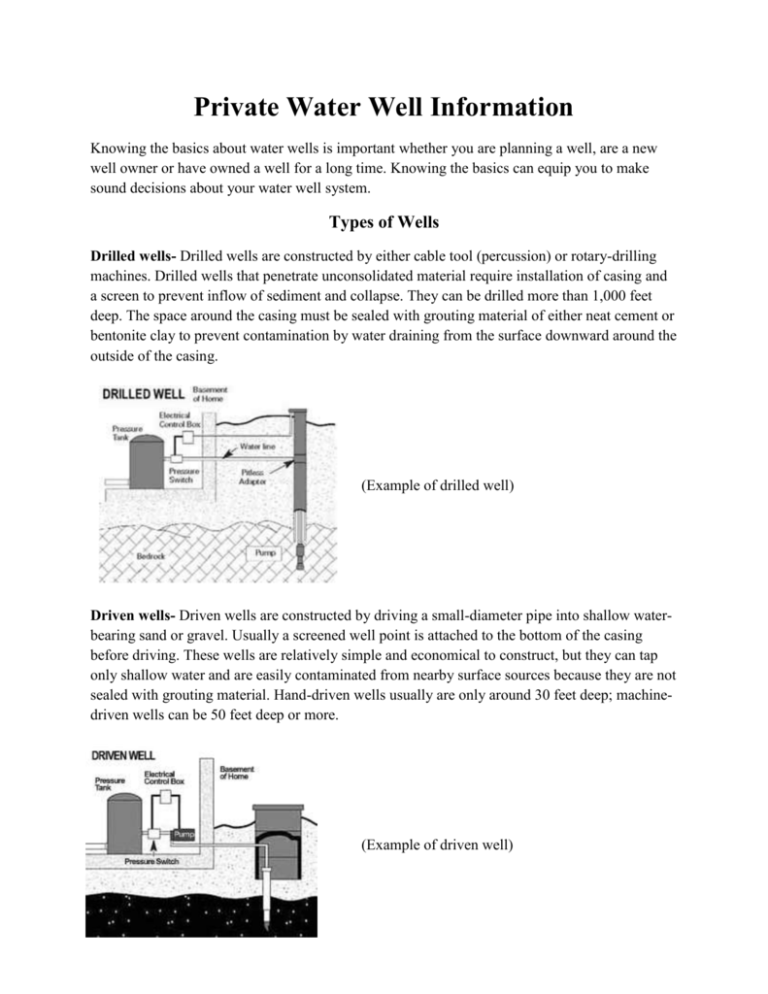
Private Water Well Information Knowing the basics about water wells is important whether you are planning a well, are a new well owner or have owned a well for a long time. Knowing the basics can equip you to make sound decisions about your water well system. Types of Wells Drilled wells- Drilled wells are constructed by either cable tool (percussion) or rotary-drilling machines. Drilled wells that penetrate unconsolidated material require installation of casing and a screen to prevent inflow of sediment and collapse. They can be drilled more than 1,000 feet deep. The space around the casing must be sealed with grouting material of either neat cement or bentonite clay to prevent contamination by water draining from the surface downward around the outside of the casing. (Example of drilled well) Driven wells- Driven wells are constructed by driving a small-diameter pipe into shallow waterbearing sand or gravel. Usually a screened well point is attached to the bottom of the casing before driving. These wells are relatively simple and economical to construct, but they can tap only shallow water and are easily contaminated from nearby surface sources because they are not sealed with grouting material. Hand-driven wells usually are only around 30 feet deep; machinedriven wells can be 50 feet deep or more. (Example of driven well) Dug wells- Historically, dug wells were excavated by hand shovel to below the water table until incoming water exceeded the digger’s bailing rate. The well was lined with stones, bricks, tile, or other material to prevent collapse, and was covered with a cap of wood, stone, or concrete tile. Because of the type of construction, bored wells can go deeper beneath the water table than can hand-dug wells. Dug and bored wells have a large diameter and expose a large area to the aquifer. These wells are able to obtain water from less-permeable materials such as very fine sand, silt, or clay. Disadvantages of this type of well are that they are shallow and lack continuous casing and grouting, making them subject to contamination from nearby surface sources, and they go dry during periods of drought if the water table drops below the well bottom. (Example of dug well) Annual Testing Information Schedule Your Annual Water Well Checkup- Wells tapping ground water resources can provide drinking water of the highest quality. Owning a private household-supply water well allows homeowners to control their own water supply. Ownership also comes with the responsibility of keeping the water well in good working order. Why is a Checkup Important? A properly constructed and maintained household-supply well will provide you with many years of quality service. The National Ground Water Association recommends routine annual maintenance checks to ensure the proper operation of the well and prolong its years of service, as well as monitor the water quality. Other Steps to Maintain Your Water Well: •Keep hazardous chemicals, such as paint, fertilizer, pesticides, and motor oil far away from your well, and maintain a “clean” zone of at least 50 feet (15.24 meters) between your well and any kennels or livestock operations. Also, always maintain proper separation between your well and buildings, waste systems, or chemical storage areas. Your professional water well contractor is familiar with the applicable local codes. •Periodically check the well cover or well cap on top of the casing (well) to ensure it is in good repair and securely attached. Its seal should keep out insects and rodents. •Keep your well records in a safe place. These include the construction report, and annual water well system maintenance and water testing results. •Get your water tested anytime there is a change in taste, odor or appearance, or anytime the system is serviced. Homeowner’s Checklist Properly constructed private water supply systems require little routine maintenance. These simple steps will help protect your system and investment: 1. Always use licensed or certified water well drillers and pump installers when a well is constructed, a pump is installed, or the system is serviced. 2. An annual well maintenance check, including a bacterial test, is recommended. Drinking water should be checked any time there is a change in taste, odor or appearance, or when the well system is serviced. 3. Keep hazardous chemicals, such as paint, fertilizer, pesticides, and motor oil far away from your well. 4. Periodically check the well cover or well cap on top of the casing (well) to ensure it is in good repair. 5. Always maintain proper separation between your well and buildings, waste systems or chemical storage facilities. Your professional contractor knows the rules. 6. Don’t allow back-siphonage. When mixing pesticides, fertilizers, or other chemicals, don’t put the hose inside the tank or container. 7. When landscaping, keep the top of your well at least one foot above the ground. Slope the ground away from your well for proper drainage. 8. Take care in working or mowing around your well. A damaged casing could jeopardize the sanitary protection of your well. Don’t pile snow, leaves, or other materials around your well. 9. Keep your well records in a safe place. These include the construction report, as well as annual water well system maintenance and water testing results. 10. Be aware of changes in your well, the area around your well, or the water it provides. 11. When your well has come to the end of its serviceable life (usually 20+ years), have a qualified water well contractor decommission it after constructing your new system. Contact Information Fulton County Health Dept 700 E Oak Street Canton, IL 62520 309-647-1134 Ext. 230 Visit wellowner.org for more information on wells








